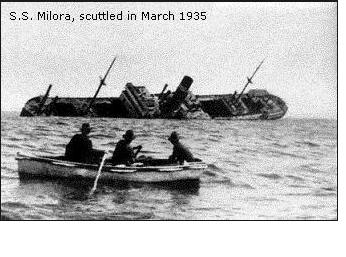
There has been a long history of sea dumping in Bass Strait, which is the discarding of material into the ocean from vessels, platforms or aircraft. Since European settlement, the following have been dumped in Bass Strait:
chemical and industrial waste;
defence waste (ammunition, etc);
dredge spoil;
human bodies (burial at sea); and
obsolete vessels.
Throughout the 1920s sea dumping was widely used as a method of disposal, but with this came an increase in the number of dumping related mishaps. For example, a failure to scuttle the 567-ton barque NORWESTER saw her hulk end up on the popular tourist beach at Portsea in November 1928. In a separate incident in February 1932 the wooden barques PALACE (339 tons) and BIRCHGROVE (381 tons) were disposed by incineration (set alight) off the Nobbies at Phillip Island. This practice was not successful as both vessels failed to sink, but instead ended up on Phillip Island, still ablaze, until eventually claimed by the rocky coastline. Public outcry at such mishaps saw the introduction of sea dumping legislation in 1932 by the Federal Government. These new laws placed restrictions on the type of material that could be dumped and identified 14 Commonwealth areas for disposal of obsolete vessels in Australian waters.
Commonwealth Area #3 is the designated Victorian zone for sea dumping of obsolete vessels. Area #3 is 6 kilometres in diameter and ranges in depth from 40 to 60 metres and is located approximately 10 kilometres south west of Barwon Heads. In 1981 the statutory rules were reviewed and updated so as to align with International legislation, thus further restricting what could be dumped in the ocean and updating the Commonwealth Sea dumping areas. Commonwealth Area #3 was first used in March 1935 with the scuttling of the 3347-ton S.S. MILORA. The MILORA, after a rather dubious career of accidents, ran aground on Point Lonsdale Reef at Port Phillip Heads in September 1934. After being refloated and towed to Melbourne for inspection, she was deemed too expensive to repair, was stripped of all valuable items and scuttled in Area 3. Her end was as error-prone as her life, the work crew overshooting the designated scuttling zone and sinking the vessel 1 kilometre outside the Area 3 boundary. The last vessel listed as being scuttled in Area 3 was the dumb hopper barge VHB 53 in 1971.
Prior to 1935 obsolete vessels were not dumped in Commonwealth Area #3, but outside the Port Phillip Heads 3 mile port limit. Unfortunately (for us), disposal crews favoured no single spot for disposal with vessels being scuttled over a wide area between Barwon Heads and Port Phillip Heads. The earliest official record of a scuttling in Bass Strait occurred in July 1913 with disposal of 375-ton iron barque BRUNETTE. The last vessel to be scuttled outside the Heads was the 150-ton Attack Class Patrol boat BAYONET in September 1999.
Having dived the Milora numerous times over the years, we have reached the conclusion that although she was the biggest ship to be scuttled in the "Graveyard", very little is known about her origins or how she became dumped of Torquay. Being located at a depth of 40 metres, with brilliant sunshine at the surface, it can be like diving at dusk or night which adds to the narcotic effect of depth. The effects of narcosis when diving on her means that divers can have real difficulties with identifying her various sections, even the holds and stern sections, are not that obvious.
|